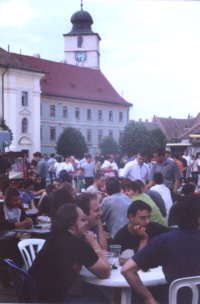Sibiu
|
|
Missing image Sibiu_in_Romania.png Map of Romania showing Sibiu |
Missing image Sibiu_Center_Skyline.jpg Historical Center Skyline, 2004 |
Sibiu (Hungarian: Nagyszeben, German: Hermannstadt) is a city in Transylvania, Romania with a population of 170,000. It straddles the river Cibin, a tributary of the river Olt.
It is the capital of Sibiu County.
| Contents |
History
The city is built near the Roman city of Caedonia, which was probably deserted at the beginning of the Dark ages, after the Roman withdrawal. The city was founded in 1190 by German colonists (saşi) settled in this area. In the 14th century, it was already an important trade center and in 1376 a document mentions that the craftsmen where divided in 19 guilds. It became the most important ethnic German city among the the "seven cities" that gave Transylvania its German language name of Siebenburgen, and it was home of the Academia Saxorum, a German Parliament of Transylvania. In the 17th century, it was the easternmost city considered to be part of Western civilization (and the easternmost city that was included in the European postal routes).
After World War I, when Austria-Hungary was dissolved, Sibiu became part of Romania; still the majority of its population were ethnic Hungarians or Germans. Only after 1990 did most of the city's ethnic Germans migrate to Germany. Among the roughly 2000 who remained was Klaus Johannis, who is currently mayor of Sibiu.
Population
As of approximately 2002, Sibiu has a population of about 170,000. The ethnic breakdown is as follows:
- Romanians 95%
- Hungarians 2%
- Germans 1,6%
- other 1,4%
Most of the population is of the Romanian Orthodox religion. Protestants and Roman Catholics represent 4% of the population.
- 25% of the population are over 50 years old
- 18% of the population have graduated from some form of university
Economy
Sibiu is one of the most prosperous cities of Romania, and also receives one of the highest rates of foreign investment in the country. It has an international airport with daily connections to Germany and, via Timişoara, to Italy.
Employment breakdown by economic sector
- Industry - 49%
- Commerce - 15%
- Construction - 7.5%
- Health - 7.5%
- Education - 7%
- Transport - 6.5%
Tourism
Tursib is the city's transport system. Sibiu/Hermannstadt will be (together with Luxembourg) the European Capital of Culture in 2007 - [1] (http://www.sibiu2007.ro). Its historical city center has been declared a UNESCO World Heritage Site in 2004. Many of its medieval fortifications (which were assigned to the guilds) have been preserved in excellent state.
Famous natives
- Alina Ciorogariu, miss Tourism World 2003
- Andrei Codrescu, writer
- Sabina Cojocar, gymnast
- Hermann Oberth, space flight technology pioneer
- Nicolaus Olahus, archbishop of Hungary
- Radu Vasile, Prime Minister of Romania
External Links
- Sibiu Online - Official Site (http://www.sibiu.ro) with information about tourism, history, pictures and more. In Romanian, English and German language.
- Samuel von Brukenthal Foundation (http://www.brukenthal.org/en); about the summer residence of the Baron Samuel von Brukenthal (1721-1803) in Sibiu
- Sibiu European Cultural Capital 2007 - Official Site (http://www.sibiu2007.ro)
- Wikitravel: Sibiu (http://wikitravel.org/en/Sibiu)
- Romania's localities
bg:Сибиу de:Sibiu eo:Sibiu hu:Nagyszeben ja:シビウ nl:Sibiu ro:Sibiu wa:Sibiu

